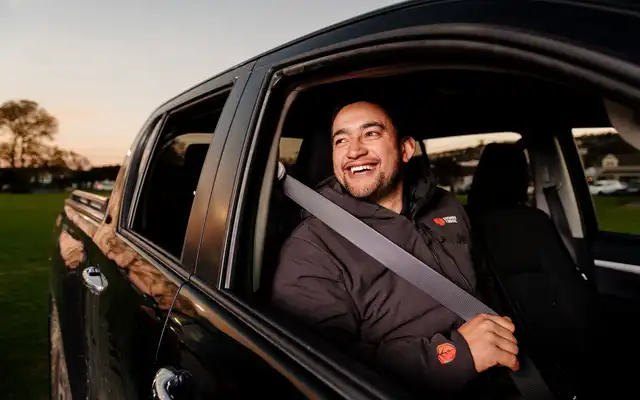Safety is something we’ve mentioned before – but here’s another chance to put it at the forefront of your mind. Our goal is getting people safely on the road, and that means the right decisions and the right cars for them – whatever that looks like.
We were lucky to get some insights from Greg Harnet of MTF Finance Kerikeri. Greg’s been in the vehicle industry for the last 30 years, and a part of MTF Finance for 20 – so he’s seen his fair share of vehicles! He also knows more than most about what it means to get safely on the road. Here’s what he reckons you need to consider for your next vehicle.
Booster and baby seats
If you want to look at baby or booster seats for your car, then make sure you’ve got ISOFIX anchor points to mount your seat and make sure it doesn’t go sliding about. This should be a no-brainer!
I always recommend that you try out your current seat in the car you’re looking at and test drive it with the whole family for space and sizing. Will you be able to fit it with ease? How much space will it take up? Do you need us or another specialist to fit it for you? Whatever the case, don’t put it off.
Harnesses for pets
We have a beagle, and we do a lot of travelling up north. I’m not comfortable with the idea of my dog being loose in the back seat. Not only does that mean she’s at risk of moving about when we’re on the go, but if we come to a stop, there’s a good chance she’ll suffer in a big way – and become something of a weapon in the car!
The best solution I’ve found is a seatbelt-ready harness: you unclip your pooch from its lead, then straight into the seatbelts. If there is an impact, the seatbelt works the same way, and the harness is a lot safer than a collar. She’s now as safe as any passenger, and best positioned to have the airbags do their work at the same time. Harnesses are available for dogs up to 40kg – so beyond that, a fixed cage in the boot might be the safer bet.
Luggage of all sizes
If you’ve got a briefcase, overnight satchel, a gym bag or weekend case, then slip it in the foot well behind the front seat. If it’s bigger, then put it in the boot.
Like loose pets, loose luggage slides around when you hit the corners, and goes flying during an impact. Smaller pieces are most stable in the footwell behind you; modern cars have tie-down points for luggage in the boot. I’d also recommend getting an anti-skid rubber mat for the boot to stop that sliding too – it’s worth its weight in gold.
When breakdowns happen…
We Kiwis love our road trips, so it helps to know that you’re covered if something goes wrong – and you can get back behind the wheel as soon as possible. Having a breakdown service on call also means that you don’t have to risk leaving your car on your own.
Start by making sure you’ve got a full health kit and hazard kit so you’re prepared for blowouts and breakdowns. But then you’ve got to get rolling again – and you can’t always call up a parent to give you a tow.
The number one service – and for good reason – is AA Roadservice. But if something’s wrong with your car that can’t be quick-fixed or needs cover, then having Mechanical Breakdown Insurance (MBI) could save you a big headache by covering the costs to repair the actual cause of failure as a result of a breakdown in New Zealand. When you get a loan with MTF Finance you get access to their insurance partner Autosure for some pretty comprehensive insurance coverage.
Getting the right size for you
When you’re buying a car, you’ve got to be really conscious about how much room is available.
Get the whole family in the prospective car and go for a test drive. There’s got to be enough space for everyone to be safely seatbelted, and for their luggage to be secured. When there’s not enough room, people start putting things on their laps or cutting corners – and that’s when accidents happen.
On a related note, I definitely steer people away from cars with lap-only belts (i.e. the ones in the middle of the back seat of older cars) if they want to put three people in the back. You’re unlikely to encounter this in newer cars, which tend to have three-point belts everywhere, but it’s another high risk in a crash. Do your whānau a favour and make sure you’ve got the features that’ll look after them.

Our team of local lending experts are here to help you into your next vehicle.
Loans and waivers
Taking out a loan keeps your cash liquid and gets you on the road sooner. One of the big concerns for many people is What happens if I can’t make my loan payments?
MTF Finance has a Payment Waiver option that can take care of your repayments if you have a major life event such as redundancy, injury, serious illness, or even death. It’s a way of knowing that you and your family will be protected and have one less thing to worry about, even if the worst happens.
Each car – and each fuel – drives differently
If you’re going between a petrol, diesel, or electric car, then you might be surprised with how the power is delivered to the wheels when you need it. The performance of a car is as much about the engine size as it is the fuel it takes, so with each vehicle or fuel comes the need to re-learn how to drive.
That extends to carrying loads, too – when you’ve got a full car or a boat in tow, then you should be prepared for the extra stopping time and the additional space you need to join the flow of traffic.
You might take for granted just how different each vehicle and fuel feels. I had one client who described going from a petrol car to an electric as being as different as going from a car to a motorbike – you have to learn a new way of driving (or riding) that suits the engine.
Who is your car for?
It’s the million-dollar question, and usually, the first one to answer when you’re shopping for a new car – and Rhys Pocklington of Black and White Motors in Christchurch has already given a great rundown on choosing the best vehicle for your needs.
Our business at DriveTown is mainly repeat referrals, and that’s one of the privileges of being in this industry for so long. We’re often finding cars for the family members or kids of people we’ve helped before, which means they’re concerned about safety – and rightly so!
I had a scare myself a few years back when my daughter wrote off her first car. It reinforced the need to have the full set of airbags, including pillar airbags, and I’m very conscious of how important anti-locking brakes are. She was unscathed – and very lucky.
For any driver, from the newest to the most experienced, getting a car that’s going to suit your needs and protect you when it matters is only a tiny part of the equation.
No matter what you’re looking for, I agree that safety has to be number one. That’s more than features, of course. Later model cars will have a lot of the safety features that we’ve come to expect: eight-point airbags, ABS, even blind-spot detection, and lane control. They add great value to a car, but they’re no alternative to good driving. Be safe and road smart out there – and know that you’ve got the extra features backing you up.
We hope you enjoy many years of hassle-free driving! For any questions about financing your next vehicle, give us a call - our team will be happy to talk you through it.


